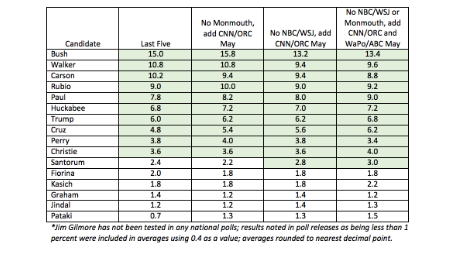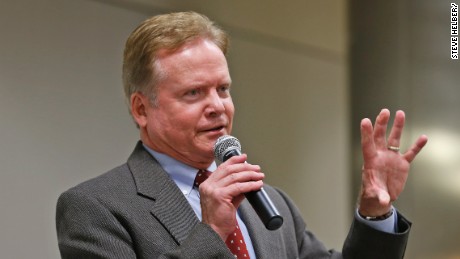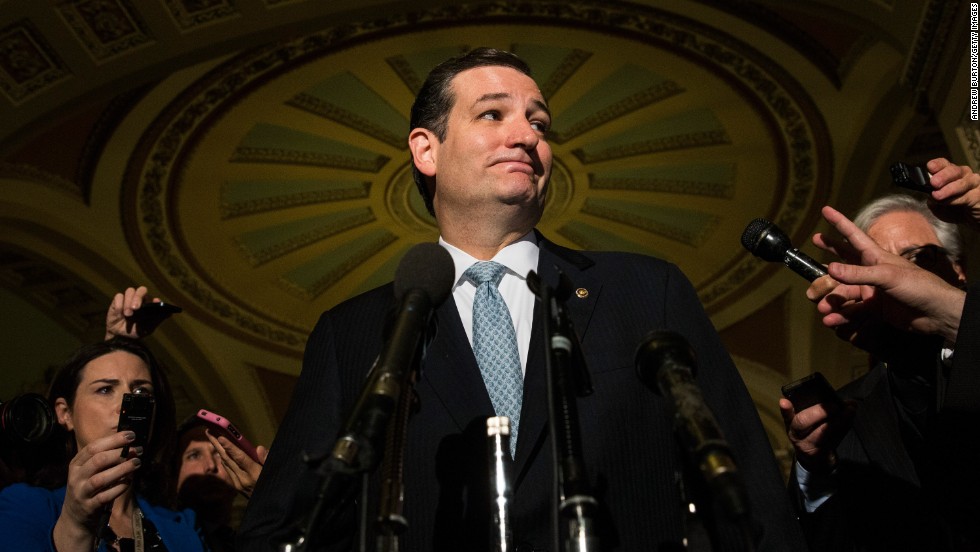Washington (CNN)Four weeks from Thursday night, a group of at least 10 Republican candidates for president will take the debate stage in Cleveland, Ohio, with polling playing a major role in determining which candidates out of the ever-expanding field get to be behind a podium — and which will be watching from home.
Fox News, which is co-sponsoring the debate with Facebook, has said that those on the stage must “place in the top 10 of an average of the five most recent national polls, as recognized by FOX News leading up to August 4th at 5 PM/ET. Such polling must be conducted by major, nationally recognized organizations that use standard methodological techniques.”
That description, as pollsters will tell you, isn’t quite as easy to interpret as it seems.
Taking it at its most literal, the most recent five polls include the CNN/ORC poll conducted June 26-28, the Fox News poll conducted June 21-23, the NBC/Wall Street Journal poll conducted June 14-18, the Monmouth University poll conducted June 11-14 and another Fox News poll conducted May 31-June 2. All of these are telephone polls conducted by live interviewers, dialing random samples of adults reached on both cellphones and landline telephones.
Although Fox News hasn’t specified how they define a standard polling methodology, this almost certainly meets that standard.

RELATED: How another Clinton overcame an honesty deficit
If those five polls are included, using results among registered voters — rather than adults where applicable — and assuming the entire field meets Fox’s other criteria for appearing on stage by filing with the Federal Election Commission and paying the appropriate filing fees, the 10 on stage would be: former Florida Gov. Jeb Bush, Wisconsin Gov. Scott Walker, neurosurgeon Ben Carson, Florida Sen. Marco Rubio, Kentucky Sen. Rand Paul, former Arkansas Gov. Mike Huckabee, businessman Donald Trump, Texas Sen. Ted Cruz, former Texas Gov. Rick Perry and New Jersey Gov. Chris Christie.
Left on the outside looking in are former Pennsylvania Sen. Rick Santorum, former CEO Carly Fiorina, Ohio Gov. John Kasich, South Carolina Sen. Lindsey Graham, Louisiana Gov. Bobby Jindal, former New York Gov. George Pataki and former Virginia Gov. Jim Gilmore, who hasn’t been tested in any national polling this cycle.

Looking at how these averages could vary depending on how Fox defines its criteria, the only candidate in that outside group who seems to stand a chance of getting inside is Santorum, and then only by tying for 10th.
If Monmouth University’s polling is not considered major, then the average would roll in the CNN/ORC poll from May 29-31. That wouldn’t change who winds up on the stage, though there is a bit of shifting in the order of finish.
One change that could have a greater impact would be dropping the NBC/Wall Street Journal poll due to the unconventional question wording used to gauge Republicans’ preferences for the nomination. In their June survey, the pollsters asked those who said they would vote in the Republican primary if they could see themselves supporting each of 16 candidates.
Rather than repeating that list of 16 candidates in their horse race question, they followed those individual questions by asking, “If the next Republican primary for president were being held today, which one of the following candidates would you favor: Jeb Bush, Scott Walker, Rand Paul, Marco Rubio, Chris Christie, Mike Huckabee, Ted Cruz, Rick Perry, or Ben Carson, or would you vote for one of the other candidates that were mentioned in the previous question?”






























Their results using this construction showed greater support for some of the nine named candidates than they received in other polls conducted around the same time.
For example, 22% said they would back Bush, compared with 9% in the Monmouth poll conducted just before their poll and 15% in the Fox poll conducted just after. Likewise, Rubio stood at 14% in the NBC/WSJ poll, compared with 9% in Monmouth’s survey and 8% in the Fox poll. And Walker had 17% in their poll, compared with 10% in Monmouth and 9% in Fox.
If that wording structure is different enough to disqualify the generally well-regarded poll from those using “standard methodological techniques” and the CNN/ORC poll from May is included instead, the averages shift fairly dramatically, though again the composition of the debate stage doesn’t change much.
The main change: If the averages are rounded to the nearest whole number, Santorum and Perry are tied for 10th place, meaning both would be on stage, adding up to a total of 11 candidates.
Santorum could also reach the stage as the 11th candidate via a tie if the averages are rounded if both NBC/Wall Street Journal and Monmouth are excluded, with the May CNN/ORC poll and a Washington Post/ABC News poll conducted May 28-31 included instead.
Until Fox releases a more detailed description of which polls meet its standards, it’s impossible to know which group of 10 will stand before the cameras on August 6. But if it were held today, it’s clear that those candidates averaging 2 points or less would be left out.
Sent from my Tricorder
